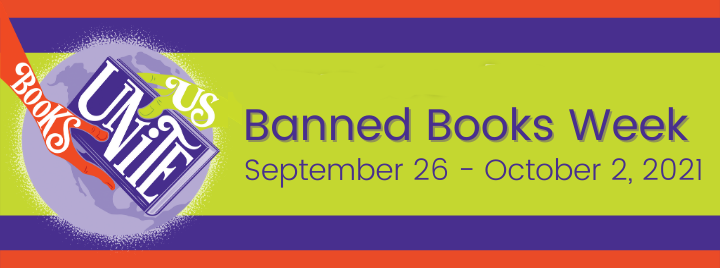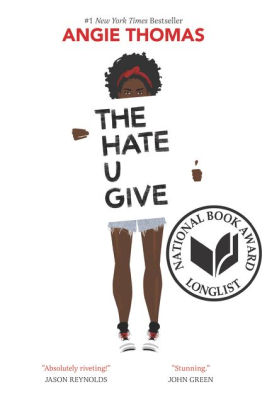What gets “banned” in today’s overwrought culture conflicts?

When Emily Whitten and I launched Redeemed Reader in 2011, one of our first projects was to observe the ALA’s Banned Books Week with our own Christian perspective. The year was propitious; Megan Cox Gurden had ignited a firestorm with a Wall Street Journal article on “Dark YA” books, and authors, editors, and booksellers were piling on. Teens needed books that reflected their own experience (so the logic went). In fact, some of that “dark” literature had saved lives. #YA Saves even became a popular hashtag.
Some of that furor has abated, partly because controversial books don’t raise as much controversy. But Banned Books week, first instituted in 1982, rolls along with public events throughout the USA. This year, it’s September 26-October 2. In anticipation of the event, every spring the American Library Association releases a list of “Most Challenged Books” from the previous year. The word “Challenged” is well-advised, as most “banned” books are not actually removed from library shelves. And even if they were, determined readers could still purchase them.
Some perennial favorites appear on the current list, but “demands to remove books addressing racism and racial justice or those that shared in the stories of Black, Indigenous, or people of color grew in number,” according to the ALA press release. Also, “books addressing themes and issues of concern for LGBTQIA+ people continued to dominate the list.”
Here’s our analysis of the 2010 list. A comparison with the 2020 list (expanded below) shows how cultural concerns shift and bend. Here we go:
1. George, by Alex Gino

The problem: LGBTAIA+ content, conflicting with a religious viewpoint, and not reflecting “the values of our community.” I’ve read it, and it’s only middling as fiction, but deceptive in its cheerleading for gender transitioning. The title character, who transitions to “Melissa,” looks forward to hormone therapy and eventual surgery, with no regrets or ill effects.
2. Stamped: Racism, Antiracism, and You by Ibram X Kendi and Jason Reynolds
The problem: claims that the book contains “selective storytelling incidents” and does not encompass racism against all people. Er . . . yes, that’s true. We’ve reviewed and talked about Stamped, and while we wouldn’t ban it, we would strongly recommend reading it alongside a more balanced account of American history.
3. All-American Boys by Jason Reynolds and Brendan Kiely
The problem: profanity, drug use, alcoholism, and anti-police views; “too much of a sensitive matter right now.” Betsy and I discussed All-American Boys with the view that it was worth both discussing and reading with mature teens.
4. Speak by Laurie Halse Anderson
The problem: anti-male bias, political viewpoint, and inclusion of rape and profanity. Well, the novel is about a rape, so that part has to be included (and the depiction isn’t graphic). There might be anti-male bias, but I had other problems with Speak.
5. The Absolutely True Diary of a Part-Time Indian by Sherman Alexie
The problem: profanity, sexual references, and allegations of sexual misconduct by the author. This book is the only one common to both the 2020 and the 2010 lists. Sherman Alexie was uniformly lionized by industry professionals until he was himself “banned” for (allegedly) hitting on young women at book conferences. Nevertheless, True Diary is worth a read by mature teens for its searing depiction of reservation life.
6. Something Happened in Our Town: A Child’s Story about Racial Injustice, by Marianne Celano, et al.
The problem: “divisive language,” anti-police views. I haven’t read it, so I can’t say.
7. To Kill a Mockingbird by Harper Lee
The problem: racial slurs and a faulty perception of the black experience; also the hero as a “white savior” figure. Of course, for years Mockingbird was a staple of high-school reading lists and generations of students testify to its effect on their attitudes toward race. Today, the anti-racism of Kendi and others challenges the virtue of historical “white saviors” like Abraham Lincoln, so Atticus Finch is not as admirable as he used to be.
8. Of Mice and Men by John Steinbeck
The problem: Racial slurs and racist stereotypes, and their negative effects on students. This is another reading-list classic, but it’s been so long since I’ve read it, I don’t remember the slurs. Since the main storyline is about the friendship between two extraordinarily needy white men, race is incidental to the plot, not central to it. But the book’s high profile makes it a target.
9. The Bluest Eye by Toni Morrison
The problem: sexually explicit, plus depictions of child abuse. The Bluest Eye is an adult novel. I wasn’t aware that it was on high school reading lists, but many classics by white authors (see #7 and #8, above) are now being replaced by classics by black authors. Mildred Taylor’s Logan Family series, especially the last (All the Days Past, All the Days to Come) would be a good substitute for Toni Morrison’s work, but it might be considered too tame these days.
10. The Hate U Give by Angie Thomas

The problem: Profanity and an anti-police message. The Hate U Give (reviewed here) begins with a horrific case of police brutality, of a type that’s true to life but seems rare. It’s worth reading by mature teens as an honest exposition of a black perspective.
Speaking generally, challenges to classic works comes from the left, while protests about more recent novels comes from the right. Other novels for teens, and even middle-graders, may be more explicit or objectionable, but not as high-profile. Children’s books have been challenged for specious reasons, as shown in this Publishers Weekly article. For the most part, though, concerns on both sides are understandable if overwrought, but there are better ways to approach the problem than hostile confrontation. Christians, especially, have an obligation to “overcome evil with good” and reach out positively rather than reacting negatively. As a kickoff to our original Banned Books Week, Emily had some helpful thoughts about how to appreciate and befriend your local librarian
Children do need protection from damaging ideas and images until they are mature enough to evaluate them. That’s still the parents’ job, not the librarian’s or the school board’s. That’s also the main reason Emily and I (and later Betsy, Megan, and Hayley), started Redeemed Reader: “Reading ahead for you” is not just a byline: it’s what we do!
More at Redeemed Reader:
- See Emily’s answer to the #YA Saves hashtag: “The Lord Saves.”
- More on the Megan Cox Gurden controversy.
- We rounded out our original Banned Books Week with book recommendations from prominent Christian editors, authors, and bloggers.
Support our writers and help keep Redeemed Reader ad-free by joining the Redeemed Reader Fellowship.
Stay Up to Date!
Get the information you need to make wise choices about books for your children and teens.
Our weekly newsletter includes our latest reviews, related links from around the web, a featured book list, book trivia, and more. We never sell your information. You may unsubscribe at any time.
We'd love to hear from you!
Our comments are now limited to our members (both Silver and Golden Key). Members, you just need to log in with your normal log-in credentials!
Not a member yet? You can join the Silver Key ($2.99/month) for a free 2-week trial. Cancel at any time. Find out more about membership here.
3 Comments
Leave a Comment
You must be logged in to post a comment.


It’s gratifying to hear that the ALA has (apparently) responded to criticism and is calling these books “challenged” instead of the overly melodramatic “banned.”
I am very much gratefull for this … “Children do need protection from damaging ideas and images until they are mature enough to evaluate them. That’s still the parents’ job, not the librarian’s or the school board’s. ”
I am reading this blog from Slovakia as afather and a small publishing company owner and you already helped me to choose one series to publish in Slovak language – The Wingfeather Saga
Again, thanks for what you are doing.
Martin: Wonderful! We are very much grateful in turn. 🙂